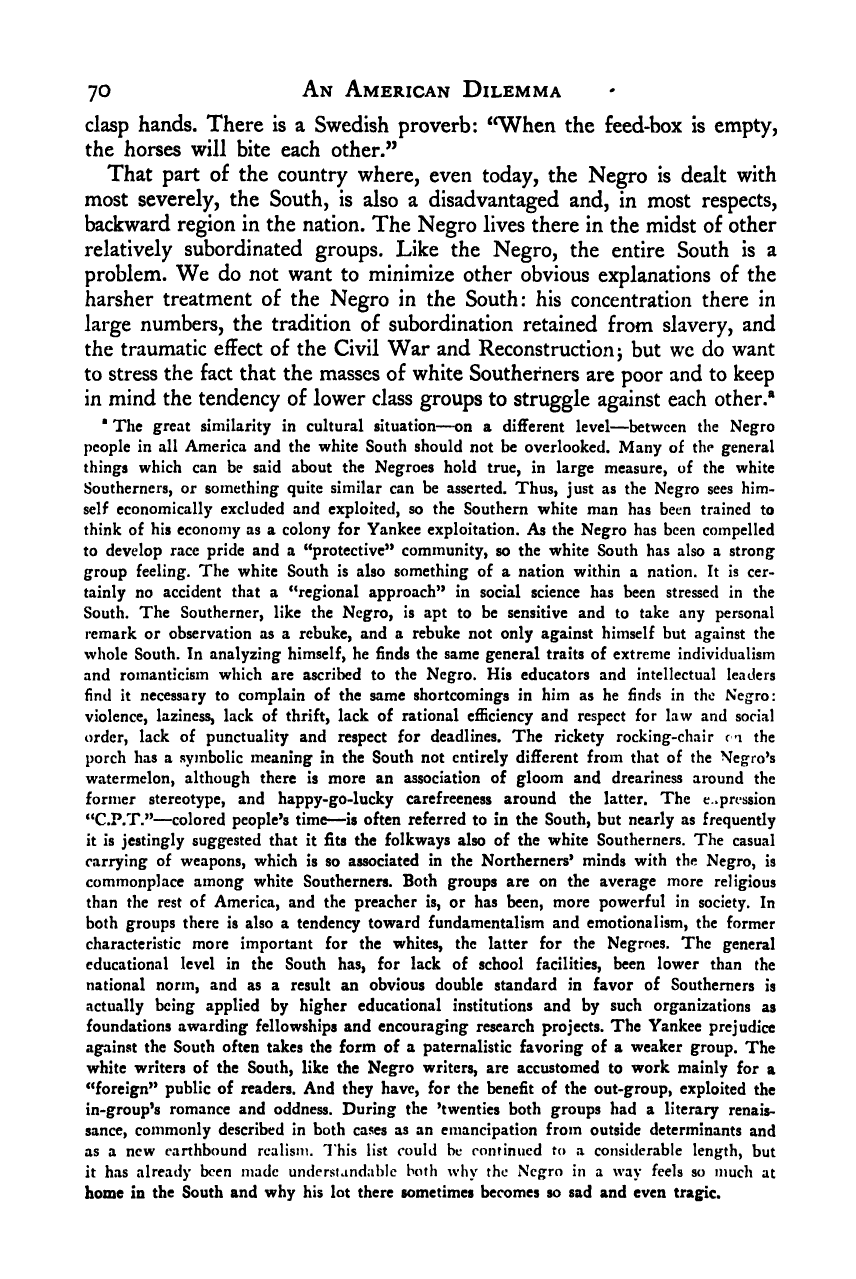Note: Gunnar Myrdal died in 1987, less than 70 years ago. Therefore, this work is protected by copyright, restricting your legal rights to reproduce it. However, you are welcome to view it on screen, as you do now. Read more about copyright.
Full resolution (TIFF) - On this page / på denna sida - I. The Approach - 3. Facets of the Negro Problem - 5. Relationships between Lower Class Groups

<< prev. page << föreg. sida << >> nästa sida >> next page >>
Below is the raw OCR text
from the above scanned image.
Do you see an error? Proofread the page now!
Här nedan syns maskintolkade texten från faksimilbilden ovan.
Ser du något fel? Korrekturläs sidan nu!
This page has never been proofread. / Denna sida har aldrig korrekturlästs.
70 An American Dilemma
clasp hands. There is a Swedish proverb: ^When the feed-box is empty,
the horses will bite each other.”
That part of the country where, even today, the Negro is dealt with
most severely, the South, is also a disadvantaged and, in most respects,
backward region in the nation. The Negro lives there in the midst of other
relatively subordinated groups. Like the Negro, the entire South is a
problem. We do not want to minimize other obvious explanations of the
harsher treatment of the Negro in the South: his concentration there in
large numbers, the tradition of subordination retained from slavery, and
the traumatic effect of the Civil War and Reconstruction j
but we do want
to stress the fact that the masses of white Southerners are poor and to keep
in mind the tendency of lower class groups to struggle against each other.®
The great similarity in cultural situation—on a different level—between the Negro
people in all America and the white South should not be overlooked. Many of the general
things which can be said about the Negroes hold true, in large measure, of the white
Southerners, or something quite similar can be asserted. Thus, just as the Negro sees him-
self economically excluded and exploited, so the Southern white man has been trained to
think of his economy as a colony for Yankee exploitation. As the Negro has been compelled
to develop race pride and a ‘‘protective” community, so the white South has also a strong
group feeling. The white South is also something of a nation within a nation. It is cer-
tainly no accident that a “regional approach” in social science has been stressed in the
South. The Southerner, like the Negro, is apt to be sensitive and to take any personal
remark or observation as a rebuke, and a rebuke not only against himself but against the
whole South. In analyzing himself, he finds the same general traits of extreme individualism
and romanticism which are ascribed to the Negro. His educators and intellectual leaders
find it necessary to complain of the same shortcomings in him as he finds in the Negro:
violence, laziness, lack of thrift, lack of rational efficiency and respect for law and social
order, lack of punctuality and respect for deadlines. The rickety rocking-chair c n the
porch has a symbolic meaning in the South not entirely different from that of the Negro’s
watermelon, although there Is more an association of gloom and dreariness around the
former stereotype, and happy-go-lucky carefreeness around the latter. The e..prcssion
“C.P.T.”—colored people’s time—is often referred to in the South, but nearly as frequently
it is jestingly suggested that it fits the folkways also of the white Southerners. The casual
carrying of weapons, which is so associated in the Northerners’ minds with the Negro, is
commonplace among white Southerners. Both groups are on the average more religious
than the rest of America, and the preacher is, or has been, more powerful in society. In
both groups there is also a tendency toward fundamentalism and emotionalism, the former
characteristic more important for the whites, the latter for the Negroes. The general
educational level in the South has, for lack of school facilities, been lower than the
national norm, and as a result an obvious double standard in favor of Southerners is
actually being applied by higher educational institutions and by such organizations as
foundations awarding fellowships and encouraging research projects. The Yankee prejudice
against the South often takes the form of a paternalistic favoring of a weaker group. The
white writers of the South, like the Negro writers, are accustomed to work mainly for a
“foreign” public of readers. And they have, for the benefit of the out-group, exploited the
in-group’s romance and oddness. During the ’twenties both groups had a literary renais-
sance, commonly described in both cases as an emancipation from outside determinants and
as a new carthbound realism. T his list could be ronriniicd to a considerable length, but
it has already been made understandable both why the Negro in a way feels so much at
home in the South and why his lot there sometimes becomes so sad and even tragic.
<< prev. page << föreg. sida << >> nästa sida >> next page >>